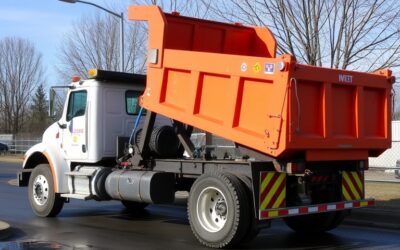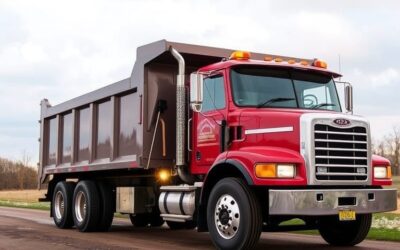Stability is crucial for dump trucks, especially in challenging environments like construction and mining. Tipping accidents can lead to injuries, costly damage, and delays. By combining proper maintenance, driver training, and advanced technology like Wink Anti-Tip, you can dramatically reduce risks and keep your operations running smoothly. Trucks carry heavy loads, often across uneven terrain, making stability a constant concern. Without proper precautions, trucks risk tipping over, leading to accidents, injuries, and costly damage.
Understanding the challenges in maintaining truck stability can help you take the right steps to mitigate risks. Regular maintenance checks and proper driver training play significant roles in ensuring that trucks remain stable during operations. These measures help identify potential issues before they escalate and equip drivers with the skills needed to handle their vehicles safely.
Additionally, technology like Wink Anti-Tip offers advanced solutions to prevent tip-overs. By automatically adjusting the truck’s balance in real-time, this technology provides an extra layer of protection. This article will explore common challenges in maintaining truck stability, daily maintenance practices, the importance of driver training, and how Wink Anti-Tip technology can make a difference.
Whether you are a fleet manager or a truck driver, following these guidelines will help you maintain stability and enhance safety in your operations.
Common Challenges in Maintaining Truck Stability
Truck stability is often compromised by challenges like uneven loading, rough terrain, and adverse weather conditions. Understanding these challenges helps operators take proactive measures to prevent tip-overs. One major challenge is uneven loading. If the cargo is not evenly distributed, the truck’s center of gravity shifts, increasing the risk of a tip-over. Ensuring that loads are balanced is critical for stability.
Another challenge is driving over uneven or rough terrain. Construction sites and mining areas often have unpredictable ground conditions. Driving on slopes or bumpy surfaces can cause the truck to become unstable. Extra caution and slower speeds are necessary when navigating these areas.
Weather conditions also affect truck stability. Rain, snow, and ice make the ground slippery, which can lead to loss of control. Poor visibility during fog or heavy rain makes it harder for drivers to assess the terrain and adjust their driving accordingly.
Mechanical failures are another significant issue. Problems with the brakes, suspension, or hydraulic system can compromise the stability of the truck. Regular maintenance checks are essential to prevent these issues from arising unexpectedly.
Lastly, driver error contributes to stability challenges. Sudden maneuvers or driving too fast, especially around corners, can cause the truck to tip. Proper training and adherence to safe driving practices are vital to minimize the risks related to human error.
Daily Maintenance Checks to Ensure Stability
Regular maintenance checks are key to keeping trucks stable and safe. Here are some essential daily checks:
1. Check Tire Pressure: Keep tires at the recommended pressure to ensure even load distribution and improve handling. Both under-inflated and over-inflated tires can cause handling issues. Make sure all tires are at the recommended pressure levels.
2. Inspect Brakes and Suspension: Check brakes and suspension daily for wear and tear to maintain stability, especially on uneven terrain for managing the truck’s load and ensuring stability. Look for signs of wear and tear and address any issues immediately.
3. Hydraulic System: Inspect the hydraulic system for leaks or malfunctions. Reliable hydraulics ensure safe dumping operations. Leaks or malfunctions can jeopardize stability. Ensure there is enough hydraulic fluid and that the system operates smoothly.
4. Load Distribution: Ensure the load is balanced to prevent shifting during transit. Use leveling tools when necessary before starting the journey. Uneven loads can shift during transit and cause the truck to tip. Use leveling tools if necessary to achieve balance.
5. Mirrors and Visibility: Clean and adjust mirrors for clear visibility, helping drivers safely navigate tight spaces and assess terrain. Clear visibility helps drivers navigate safely and assess the terrain.
6. Check for Leaks: Look for leaks in the fuel system, cooling system, and other critical parts. Any leaks need to be fixed immediately to avoid larger issues.
7. Functional Lights: Confirm that all lights, including headlights, brake lights, and signal lights, are functioning. This enhances visibility and communication with other drivers.
By conducting these daily maintenance checks, drivers can identify potential problems before they become serious. Routine checks help maintain the truck’s stability and ensure safe operations throughout the day.
Importance of Driver Training and Safe Driving Practices
Driver training is vital for maintaining truck stability. Proper training equips drivers with the skills to handle heavy loads and navigate challenging terrains safely. Here are some key aspects of driver training:
1. Understanding Load Distribution: Train drivers on load balancing techniques to prevent shifting that could destabilize the truck. Uneven loads shift the truck’s center of gravity and increase the risk of tip-overs. Training on load distribution helps drivers recognize and correct imbalances before they become a problem.
2. Safe Driving Techniques: Teach safe driving practices like gradual turns and controlled speeds, especially on rough or sloped terrain, especially when turning or driving on uneven surfaces. Sudden maneuvers can destabilize a loaded truck. Training programs should emphasize the importance of gradual movements and controlled speeds.
3. Handling Emergency Situations: Train drivers on how to react during tipping risks, including stopping movement and lowering the dump bed safely. Drivers should be trained on how to react if the truck starts to tip, including stopping movement immediately and lowering the dump bed if it’s raised. Evacuation procedures should also be part of the training.
4. Technology Use: Ensure drivers understand how to use Wink Anti-Tip technology, including responding to alerts and interpreting system data. Drivers should understand how these systems work, how they alert them to potential stability issues, and the steps to take when an alert is received.
Investing in comprehensive driver training improves safety and reduces the likelihood of accidents. Well-trained drivers are better equipped to recognize and respond to potential dangers, keeping themselves and their trucks safe.
The Role of Wink Anti-Tip Technology in Preventing Tip-Overs
Wink Anti-Tip revolutionizes dump truck safety with real-time stability monitoring and automatic adjustments. By detecting instability early and taking immediate action, this technology prevents tip-overs before they happen. This advanced system automatically lowers the truck unit when it detects instability, providing an extra layer of safety. Here’s how it works:
1. Real-Time Monitoring: Sensors placed around the truck monitor stability in real-time. These sensors detect shifts in the load and changes in the truck’s angle, which might not be noticeable to the driver.
2. Instant Adjustments: When the sensors detect instability, the system activates the hydraulic mechanism to lower the unit. This quick adjustment helps to stabilize the truck immediately, reducing the risk of a tip-over.
3. Driver Alerts: The Wink Anti-Tip system also alerts the driver when an adjustment is made. This helps drivers stay aware of the truck’s status and understand the factors that led to the instability. Being informed allows drivers to take preventive actions in the future.
4., Enhanced Safety: By providing real-time adjustments and constant monitoring, Wink Anti-Tip technology significantly enhances safety. It allows for corrections that might be impossible to make manually. This technology ensures the truck remains stable even in challenging conditions, such as uneven terrain or sudden load shifts.
Wink Anti-Tip technology is a valuable tool that complements daily maintenance checks and driver training. Its automatic adjustments and real-time monitoring provide peace of mind, knowing that the truck’s stability is constantly managed.
Final Thoughts
Safe and stable trucks are the backbone of efficient operations. From daily maintenance to driver training and advanced tools like Wink Anti-Tip, every step you take reduces tipping risks and boosts confidence on the road. Explore Wink Anti-Tip today to transform your fleet’s safety. By understanding the common challenges, performing regular maintenance checks, and investing in driver training, we can significantly reduce tip-overs risks. Each step plays a vital role in ensuring that trucks remain stable, even under demanding conditions.
Wink Anti-Tip technology offers an advanced solution to stability issues. Automatically adjusting the truck’s balance in real-time prevents potential tip-overs and provides an extra layer of safety. Incorporating this technology into daily operations enhances safety measures and gives drivers and fleet operators peace of mind.
Exploring the benefits of Wink Anti-Tip technology is a worthwhile step for those looking to improve their truck stability and ensure the safety of their operations. Visit Wink Anti-Tip today to learn more about our anti tip over device and how we can help you maintain stability and safety in your truck operations. Make tip-overs a thing of the past with Wink Anti-Tip.





